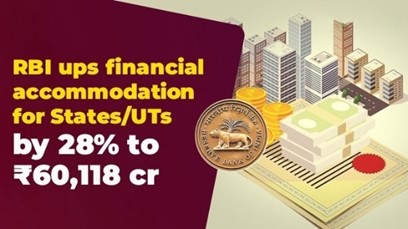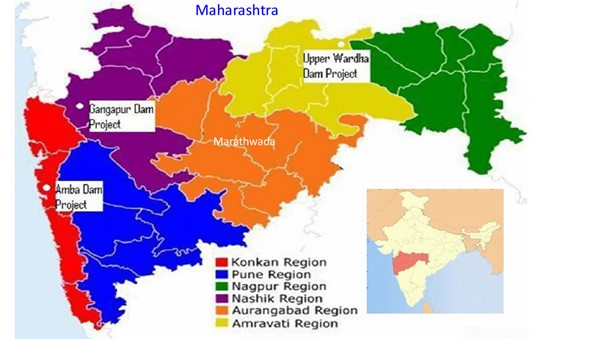Tuesday, 2nd July 2024
Conservation plan for Great Indian Bustard
Why in the news?
- Recently, the Ministry of Environment, Forest and Climate Change (MoEFCC) has approved Rs 56 crore for the next phase of the conservation of the Great Indian Bustard (GIB) and Lesser Florican.
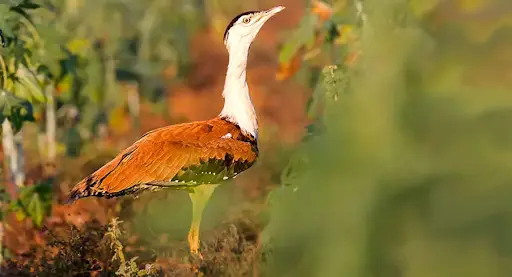
Great Indian Bustard (GIB):
- About:
- GIBs are the largest among the four bustard species found in India.
- The other three being MacQueen’s bustard, lesser florican, and the Bengal florican.
- Being terrestrial birds, they spend most of their time on the ground with occasional flights to go from one part of their habitat to the other.
- They feed on insects, lizards, grass seeds, etc. GIBs are considered the flagship bird species of grassland and hence barometers of the health of grassland ecosystems.
- Habitat and Status:
- This bird, found mainly in Rajasthan and Gujarat, has been categorised as critically endangered by the International Union for Conservation of Nature (IUCN).
- As per the 2021 report of the IUCN, they are on the verge of extinction with hardly 50 to 249 of them alive.
- GIBs’ historic range included much of the Indian sub-continent but it has now shrunken to just 10 percent of it.
- Among the heaviest birds with flight, GIBs prefer grasslands as their habitats.
- Threats:
- Scientists of the Wildlife Institute of India (WII) have been pointing out overhead power transmission lines as the biggest threat to the GIBs.
- WII research has concluded that in Rajasthan, 18 GIBs die every year after colliding with overhead power lines.
- These birds, due to their poor frontal vision, can’t detect power lines in time and their weight makes in-flight quick manoeuvres difficult.
- Kutch and Thar desert are the places which have witnessed the creation of huge renewable energy infrastructure over the past two decades.
- This led to the installation of windmills and the construction of power lines even in core GIB areas.
- Conservation Measures:
- In 2015, the Central government launched the GIB species recovery programme.
- Under the programme, the WII and Rajasthan Forest department have jointly set up conservation breeding centres where GIB eggs harvested from the wild are incubated artificially and hatchlings raised in a controlled environment.
- The plan is to create a population that can act as insurance against the threat of extinction and release the third generation of these captive-bred birds into the wild.
- Bird diverters have also been installed on power lines to protect the Great Indian Bustard (GIB) from collisions.
- The diverters act as reflectors that birds can see from about 50 metres away.
- When birds spot the diverters, they change their flight path to avoid colliding with the power lines.
Lesser Florican:
- About:
- Lesser florican is the smallest bird of the bustard family (Otididae).
- It is endemic to India and is one of the four bustard species of India.
- Locally, the bird is known as Kharmor (grass peacock) in Gujarat and Khar titar (grass pheasant) in Rajasthan.
- Habitat:
- Though it prefers open, grassy landscapes, the lesser florican is generally seen resting within thick bushes during the day.
- In non-breeding months, it can inhabit wooded lands and scrublands, along with grasslands.
- Being omnivorous, their diet ranges from small insects and critters to herbs and shoots.
- It inhabits the states of Rajasthan, Gujarat, Madhya Pradesh, and parts of Andhra Pradesh, Maharashtra, and Karnataka.
- IUCN Status:
- The bird is currently listed as Critically Endangered on the IUCN Red List.

Next Phase of Conservation Plan for the Great Indian Bustard:
Overview:
- Funding Approval: The Ministry of Environment, Forest and Climate Change (MoEFCC) has allocated Rs 56 crore for the next phase of the conservation of the Great Indian Bustard (GIB) and Lesser Florican.
- Conservation Goals: The plan includes habitat development, in-situ conservation, completion of conservation breeding centres, and releasing captive-bred birds.
- Proposal Recommendation: The National CAMPA executive committee recommended the Wildlife Institute of India’s (WII) proposal for scaling up the project for 2024-2033.
Project Components:
- First Component
- Conservation Breeding Centers: Completion of the CBC in Jaisalmer’s Ramdevra and development of the Sorsan Lesser Florican facility.
- Captive-bred Birds: Preparatory work for releasing captive-bred birds and post-release monitoring.
- Artificial Insemination: Development and implementation as a backup for captive breeding.
- Second Component
- In-situ Conservation: Efforts in other range states including Gujarat, Maharashtra, Karnataka, Andhra Pradesh, and Madhya Pradesh.
Timeline and Activities:
- Population Estimation: Between 2024-2026, WII will estimate GIB populations in Jaisalmer and range states, and conduct rangewide population estimation of the Lesser Florican.
- Egg Collection: Annually collect two to four GIB eggs and six to ten Lesser Florican eggs.
- Rewilding: Set to begin in 2027, identifying and developing release sites, and creating soft release enclosures.
Background:
- The conservation programme has been running since 2016 for the long-term recovery of critically endangered GIB and Lesser Florican.
- Currently, around 140 GIBs and fewer than 1,000 Lesser Floricans are surviving in the wild.
- Severe decline due to hunting, habitat loss, depredation of eggs, and overhead power lines.
Current Conservation Facilities:
- GIB Breeding Centers: Located in Rajasthan’s Sam and Ramdevra with 40 GIBs.
- Lesser Florican Center: Located in Sorsan with seven individuals.
Legal Oversight:
- Supreme Court Involvement:
- The SC is also monitoring the GIB and Lesser Florican conservation programme.
- A petition seeking protection of the two species is pending before it.
- Power Line Issue:
- SC initially ordered burying power lines in GIB habitats but recalled the order in 2024 due to practicality concerns.
- An expert committee is studying the issue.
|
UPSC Civil Services Examination Previous Year Question (PYQ) Prelims Q:1 Which one of the following groups of animals belongs to the category of endangered species? (2012)
Ans: (a) Q:2 With reference to India’s Desert National Park, which of the following statements are correct? (2020)
Select the correct answer using the code given below:
Ans: (c) |
Source: IE
New Criminal Law Regime
Why in the news?
- Three new criminal laws - Bharatiya Nyaya Sanhita (BNS), Bhartiya Nagrik Suraksha Sanhita (BNSS), and the Bharatiya Sakshya Adhiniyam (BSA) - came into effect across the country on July 1.
- They brought widespread changes to India's criminal justice system and ended colonial-era laws - the Indian Penal Code (1860), Code of Criminal Procedure (1973), and the Indian Evidence Act (1872).
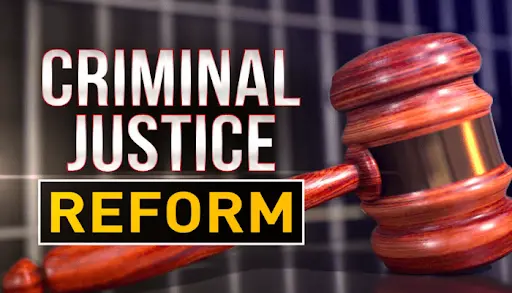
- Together, these three laws govern the criminal justice jurisprudence, from defining penal offences and prescribing processes for investigation and evidence gathering to governing the process of a trial in court.
Breaking Down the Three New Criminal Laws:
- Bharatiya Nyaya Sanhita (BNS):
- Clause 69: Penalises sexual intercourse through the employment of "deceitful means," with up to 10 years imprisonment and a fine. Deceitful means include false promises of employment or promotion, inducement, or marrying after suppressing identity. Critics argue this might criminalise consensual relationships and promote the "love jihad" narrative.
- Clause 103: Recognizes murder on the grounds of race, caste, or community as a separate offence. This provision gives legal recognition to such crimes, following the SC's 2018 directive for a separate law for lynching.
- Clause 111(1): Includes offences such as organised crime and terror, borrowing from the Unlawful Activities Prevention Act (UAPA). Organised crime covers unlawful activities including kidnapping, robbery, vehicle theft, extortion, land grabbing, contract killing, economic offences, cyber-crimes, etc.
- Clause 304(1): Defines snatching as a new crime, distinct from theft.
- Community Service as an Alternate Punishment: Applies to small theft, defamation, and attempting to die by suicide to keep a public official from discharging duty. The definition of community service is left to the judges' discretion.
- Bharatiya Nagarik Suraksha Sanhita (BNSS):
- Expansion of Detention: Extends police custody from 15 days (under CrPC) to up to 90 days.
- Victim-Centric Approach: In cases where the punishment is seven years or more, the victim must be heard before the government can withdraw the case.
- Trials in Absentia: Allows for trying and convicting a person in their absence, which critics argue might enable the state to bypass its duty to locate the accused properly.
- Statutory Bail Removal: No provision for statutory bail if an accused has more than one offence against their name.
- Bharatiya Sakshya Adhiniyam (BSA):
- Modified Definition of Document: Includes electronic and digital records, recognizing them as primary evidence with the same legal effect, validity, and enforceability as other documents.
- Expanded Scope of Secondary Evidence: Includes additional categories such as oral admissions, written submissions, etc.
- Modified Confessional Admission Requirement: Makes a confession by an accused person irrelevant in a criminal proceeding.
Upsides and Downsides of the Three New Criminal Laws:
- Upsides:
- Brings sexual intercourse with a minor wife under the ambit of rape.
- Inclusion of offences for mob-lynching signals legislative acknowledgment of such hate crimes.
- Omits the contentious Section 377 of the IPC, which criminalised “carnal intercourse against the order of nature.”
- Emphasises video-conferencing of trials and prescribes timelines for speedy trials, potentially improving justice delivery.
- Downsides Areas:
- The consultation process during the pandemic and the hasty passage of the laws through Parliament have raised concerns.
- Some legal experts argue that despite significant changes, the new laws do not "overhaul" the existing laws.
- Although the government claims to have done away with sedition, the BNS introduces the offence with a wider definition.
- The lack of gender-neutral rape laws leaves male victims of sexual assault without criminal recourse.
The Government’s Preparation for Implementing the 3 Criminal Laws:
- Operational Training:
- Educational Integration: The Bar Council of India has mandated that the new laws be incorporated into the curricula of universities and Centres of Legal Education starting from the 2024-25 academic year.
- Publicity/Awareness Campaign:
- Coordinated Efforts: The Bureau of Police Research and Development (BPR&D) is coordinating the efforts of the Inter-Ministerial Group for a comprehensive publicity campaign to raise awareness about the new laws.
- Tech Upgradation:
- NCRB Modifications: The National Crime Records Bureau (NCRB) has made 23 functional modifications to the Crime and Criminal Tracking Network and Systems (CCTNS) application to ensure tech compatibility, including the registration of FIRs.
- NIC Developments: The National Informatics Centre (NIC) has developed applications such as eSakshya, Nyay Shruti, and eSummon to facilitate the videography/photography of crime scenes, judicial hearings, and the electronic delivery of court summons.
- Capacity Building:
- Training Modules: The BPR&D has developed 13 training modules aimed at building the capacity of the police, prisons, prosecutors, judicial officers, forensic experts, and central police organisations.
|
UPSC Civil Services Examination, Previous Year Question (PYQ) Prelims: Q:1 For which one of the following reforms was a Commission set up under the Chairmanship of Veerappa Moily by the Government of India? (2008)
Ans: (d) Mains: Q:1 We are witnessing increasing instances of sexual violence against women in the country. Despite existing legal provisions against it, the number of such incidences is on the rise. Suggest some innovative measures to tackle this menace. (2014) Q:2 Mob violence is emerging as a serious law and order problem in India. By giving suitable examples, analyse the causes and consequences of such violence. (2015) |
Source: IE
NCERT’s New Report Card: PARAKH
Why in the News?
- Recently, PARAKH, a standard-setting body under the NCERT, recently released a ‘Holistic Progress Card’ (HPC) for secondary school students (Classes 9 to 12).
About PARAKH:
- National Assessment Centre- PARAKH (Performance Assessment, Review, and Analysis of Knowledge for Holistic Development) was set up in NCERT as an independent body in 2023.
- Objective: To fulfil the basic objectives of setting norms, standards, guidelines, and implementing activities related to student assessment along with other tasks as mandated by the National Education Policy (NEP) 2020.
Focus Areas:
- Capacity Development in Competency-Based Assessment: Project Vidyasagar
- PARAKH, in partnership with the PhD Chamber of Commerce, is organising workshops across India to familiarise educators with the new pedagogical and policy changes in the National Curriculum Framework 2023.
- The goal is to bridge gaps in implementing competency-based learning and teaching.
- Large-Scale Achievement Survey
- PARAKH conducted the State Educational Achievement Survey in November 2023, assessing students in Grades 3, 6, and 9 across 30 States/UTs.
- The survey aims to monitor and assess educational competencies in foundational literacy, numeracy, language, and mathematics.
- Equivalence of School Boards
- PARAKH is working to standardise examination reforms across all Indian school boards.
- Regional workshops were held to collect data on administration, curriculum, assessments, and infrastructure.
- A report was prepared, and national workshops were conducted to discuss and draft policy recommendations for equivalence.
- The goal is to allocate credit points to academic, vocational, and experiential learning.
About Holistic Progress Cards:
- About: The Holistic Progress Card (HPC) will no longer depend on marks or grades to evaluate a student’s academic performance. Instead, it will rely on a 360-degree evaluation.
- Objective: To provide a comprehensive assessment of a student’s development beyond mere academic achievements.
- Features:
- Students will be regularly assessed through class activities where they are active participants.
- Activities will prompt students to apply diverse skills and competencies, demonstrating their grasp of concepts.
- The difficulty level experienced by students while performing tasks will be assessed.
- Teachers will register students' strengths such as collaboration, following instructions, creativity, or empathy, and weaknesses like lack of attention, peer pressure, or lack of preparation.
- The HPC allows students to evaluate their own and their classmates’ performance with simple responses like ‘Yes’, ‘No’, or ‘Do not know’ to descriptive statements.
- It incorporates parents’ input on their child’s homework abilities, classroom engagement, and balancing screen time with extracurricular activities, making parents an integral part of the learning process.
- Benefits of HPC:
- Goes beyond numerical grades, focusing on descriptive and analytical evaluations that encompass academic achievements and the development of critical skills.
- Promotes a shift from summative to formative assessment, fostering competency-based evaluation and holistic growth.
- Provides teachers and parents with insights to support each student's learning journey.
NCERT’s New Report Card to Track Post-School Plans:
- PARAKH has recently launched a ‘Holistic Progress Card’ for secondary school students (Classes 9 to 12).
- The report card will not be used in the ongoing 2024-25 academic session, but teachers and officials will undergo training for its implementation.
- States have the option to adopt the HPC as released by NCERT or modify it according to their requirements.
- These report cards are expected to influence the results of students appearing for Board exams in Classes 10 and 12.
- Some states, including Jammu and Kashmir, Madhya Pradesh, Gujarat, Maharashtra, Haryana, and Himachal Pradesh, are preparing to introduce HPCs for students up to Class 8 starting from the 2024-25 academic session.
|
UPSC Civil Services Examination, Previous Year Question (PYQ) Prelims: Q:1 Which of the following provisions of the Constitution does India have a bearing on Education? (2012)
Select the correct answer using the codes given below:
Ans- (d) Mains: Q1. Discuss the main objectives of Population Education and point out the measures to achieve them in India in detail. (2021) Q2. How have digital initiatives in India contributed to the functioning of the education system in the country? Elaborate on your answer. (2020) Q:3 Education is not an injunction, it is an effective and pervasive tool for all-round development of an individual and social transformation”. Examine the New Education Policy, 2020 (NEP, 2020) in light of the above statement. (2020) |
Source: IE
Project-76
Why in the news ?
- Recently, the Defence Research and Development Organisation (DRDO) has initiated a preliminary study on the design and development of an indigenous conventional submarine under Project-76.

- It is anticipated that it will take up to a year before a formal case is presented to the Cabinet Committee on Security (CCS) for project sanction.
- This project continues the ATV initiative, encompassing the Arihant series of nuclear ballistic missile submarines (SSBNs) and overseeing development of nuclear-powered submarines (SSNs).
About Project-76:
- Objective: The Warship Design Bureau of the Indian Navy is developing India's first indigenous conventional diesel-electric submarine.
- Number of Submarines: The Indian Navy plans to build 12 submarines under Project-76.
- Type: Envisioned as air-independent propulsion (AIP)-equipped diesel-electric attack submarines, with an expected submerged displacement of 3,000 tons.
- Technological Leap: Represents a significant advancement beyond foreign-designed predecessors like Project-751 (India) and Project-75 submarines.
- Successor to: Aims to succeed the renowned Sindhughosh (Kilo) class, emphasising the Navy’s commitment to maintaining a robust 3,000-ton class of submarines.
- Advanced Features: Expected to include indigenous Weapon Control systems and Lithium-ion batteries.
- Technological Integration: Integrates top-tier French technology from Project 75 and expertise from German/Spanish collaborations in Project 751 (India).
- Construction Timeline: The objective is to initiate the construction of the prototype by 2028.
- Significance: Holds immense significance for India’s submarine-building capabilities, aiming to reduce reliance on foreign Original Equipment Manufacturers (OEMs) for submarine design.
|
Project-75 :
|
Current Submarine Fleet:
- Composition: The Indian Navy currently operates 16 conventional submarines, comprising:
- Seven Russian Kilo-class submarines,
- Four German-origin HDW submarines,
- Five French Scorpene-class submarines.
- Deployment: India’s submarine fleet is stationed at two main bases: Visakhapatnam on the east coast and Mumbai on the west coast.
Details of Submarine Classes:
- Kalvari Class (Scorpene-class):
- Description: INS Kalvari is the first of the six Scorpene-class submarines built under Project 75.
- Commissioned: The submarine was commissioned in 2017.
- Sindhughosh Class (Kilo-class):
- Description: These diesel-electric submarines are designated as 877EKM.
- Origin: Built under a contract between Rosvooruzhenie and the Ministry of Defence (India).
- Specifications: Displacement of 3,000 tonnes, maximum diving depth of 300 metres, top speed of 18 knots, and capable of operating solo for 45 days with a crew of 53.
- Shishumar Class (Type 1500):
- Description: Developed by the German yard Howaldtswerke-Deutsche Werft (HDW).
- Commissioning: The submarines of this class were commissioned between 1986 and 1994.
- Specifications: Displacement of 1660 tons when surfaced, speed of 22 knots (41 km/h), and a complement of 40 including eight officers.
Source: TH
Hurricanes Beryl
Why in the news ?
- Due to Hurricane Beryl affecting the Windward Islands, the victorious Indian Men’s cricket team from the T20 World Cup is currently stranded in Barbados.

About the Hurricane Beryl:
- Category and Strength: Hurricane Beryl is an early Category 4 storm with sustained winds of at least 130 mph (209 km/h).
- Location and Impact: Currently, it is impacting the Windward Islands, including Barbados, Grenada, and Trinidad and Tobago.
- Forecast: The National Hurricane Centre has issued warnings for life-threatening winds, storm surges, and flash flooding in the affected islands.
- Preparations: Local authorities in Barbados have taken precautions such as suspending school classes and shutting down the water supply in anticipation of the hurricane’s impact.
- Historical Context: Hurricane Beryl is noted as the strongest storm to affect the Windward Islands since Hurricane Ivan in September 2004.
Hurricanes - Formation and Impact:
- Formation: Hurricanes form over warm ocean waters near the equator where warm, moist air rises, creating low air pressure.
- Fuel: They are fueled by the heat and moisture evaporating from the ocean, which forms clouds and causes the storm to spin due to the Earth's rotation.
- Eye Formation: As the storm intensifies, an eye forms at its center, with storms rotating counterclockwise north of the equator and clockwise south of it.
- Climate Impact: Warmer sea surface temperatures due to climate change may lead to slower decay of hurricanes upon landfall, potentially increasing their severity.
Hurricane Severity and Trends:
- Research Findings: Studies indicate that warmer sea temperatures contribute to slower hurricane decay, potentially prolonging their destructive impacts.
- Record-Breaking Seasons: The 2020 Atlantic Hurricane season witnessed a record number of named storms, suggesting a trend towards more frequent and intense hurricane activity.
Difference between Hurricane and Tropical Storm:
- No Fundamental Difference: Hurricanes, typhoons, and cyclones are all types of tropical cyclones, distinguished by their location:
- Hurricanes: Form over the Atlantic Ocean and the eastern Pacific Ocean.
- Typhoons: Form in the Northwest Pacific Ocean.
- Cyclones: Form in the Bay of Bengal and the Arabian Sea.
- Naming Conventions: These different names reflect regional variations but denote the same meteorological phenomenon of tropical cyclones.
Recommendations:
- Advanced Forecasting: Invest in state-of-the-art meteorological tools and satellite technology to improve the accuracy and lead time of hurricane forecasts.
- Community Preparedness: Establish comprehensive community outreach programs to educate residents about hurricane risks, evacuation procedures, and emergency shelter locations.
|
UPSC Civil Services Examination, Previous Year Question (PYQ) Mains: Q:1 Discuss the meaning of colour-coded weather warnings for cyclone prone areas given by India Meteorological Department. (2014) |
Source: IE
The agenda for the 16th Finance Commission
Why in the News?
- The 16th Finance Commission established on December 31, 2023, with Dr. Arvind Panagariya as Chairman, appointed by the President of India under Article 280(1) of the Constitution.
- The 16th Finance Commission, operating under Article 280, focuses on enhancing fund devolution. Amendments like the 73rd and 74th aim to bolster state funds for panchayats and municipalities.

About Finance Commission:
- Establishment: Constituted every five years by the Union Government.
- Composition: Consists of a Chairman and four other members appointed by the President, as specified under the Finance Commission (Miscellaneous Provisions) Act, 1951.
- Current Commission: The 16th Finance Commission, chaired by Dr. Arvind Panagariya, has been notified to make recommendations for the period 2026-31.
Composition of the Finance Commission:
- Chairman: Selected from individuals with experience in public affairs.
- Members: Four members appointed by the President, fulfilling qualifications such as:
- Former or current judge of a High Court or eligible for such appointment.
- Expertise in finance and government accounts.
- Experience in financial matters and administration.
- Special knowledge in economics.
Functions of the Finance Commission:
- Distribution of Net Proceeds: Recommends how taxes' net proceeds should be distributed between the Centre and states, and among the states themselves.
- Grants-in-Aid: Determines principles governing grants-in-aid to states from the Consolidated Fund of India.
- Improving Fiscal Management: Recommends measures to augment state Consolidated Funds to support Panchayats and Municipalities.
- Any Other Matter: Addresses any finance-related matter referred by the President to ensure sound fiscal management.
|
Other countries devolve funds to their local governments:
|
Agenda of the 16th Finance Commission:
- The 16th Finance Commission is primarily focused on recommending the devolution of funds from the consolidated fund.
- Since the 73rd and 74th constitutional amendments, local bodies have gained significant recognition within the federal system.
- These amendments introduced sub-clauses 280(3)(bb) and (c), mandating the Finance Commission to recommend measures to augment State consolidated funds for supporting panchayats and municipalities.
Why is the Census significant?
- Data Dependence:
- The absence of the 2021 Census data poses challenges in accurately assessing urban growth and demographic changes crucial for evidence-based fiscal devolution.
- Urban Dynamics:
- India's landscape includes approximately 4,000 statutory towns, an equal number of Census towns, and numerous effectively urban villages, necessitating precise enumeration for effective planning and resource allocation.
- Migration Impact:
- Census data plays a critical role in capturing significant migration to Tier-2 and Tier-3 cities, influencing their infrastructure and service needs.
What about cities and the Taxation system?
- Impact of GST:
- The introduction of GST has significantly reduced ULBs’ tax revenue (excluding property tax), thereby affecting their financial autonomy.
- Low IGTs:
- Intergovernmental transfers from States to ULBs in India are minimal (around 0.5% of GDP), which is considerably lower compared to other developing nations. This exacerbates fiscal challenges for ULBs.
- Constitutional Provisions:
- Despite the 74th constitutional amendment aimed at empowering Urban Local Bodies (ULBs), progress has been slow over the past three decades, thereby impeding urban development.
- Parallel Agencies:
- The proliferation of parallel agencies and schemes such as MP/MLA Local Area Development Schemes distorts the federal structure and undermines the financial and operational autonomy of ULBs.
What are Some New Issues for the 16th FC?
- The Co-existence of the GST Council:
- Its decisions can impact revenue projections and calculations made by Finance Commissions (FCs) for sharing fiscal resources.
- There is a necessity for a mechanism enabling FCs to review their projections in response to GST Council decisions, and vice versa.
- The Funding of Defence and Internal Security:
- The Fifteenth FC was tasked later with examining the potential establishment of a separate funding mechanism for defence and internal security.
- It recommended the creation of a non-lapsable fund for this purpose, which the government has tentatively accepted, pending further implementation details.
- The Impact of Covid-19 Pandemic:
- It has underscored the importance of strengthening healthcare systems and social protection measures.
- The Sixteenth FC will need to assess the pandemic's impact on the fiscal landscape of both the Centre and States, including their expenditure priorities and needs.
Way Forward:
- Increase intergovernmental transfers to ULBs to at least 2% of GDP, ensuring predictability and earmarking for vulnerable groups.
- Strengthen constitutional provisions to empower ULBs further, reducing reliance on parallel agencies like MP/MLA Local Area Development Schemes.
- They should improve communication and outreach strategies by disseminating reports widely, gathering feedback, building awareness, and fostering consensus among diverse stakeholders.
- FCs need to adapt swiftly to evolving economic and social conditions, including challenges from GST implementation, the Covid-19 pandemic, climate change, and digital transformation.
- FCs should promote sound fiscal policies and practices, including fiscal consolidation, debt sustainability, revenue generation, and rationalisation of expenditures.
- Finance Commissions (FCs) should prioritise providing sufficient and predictable resources to both Union and state governments based on their constitutional responsibilities and expenditure needs.
- They should incentivize governments to enhance the quality and effectiveness of public spending, particularly in critical sectors like health, education, and infrastructure.
|
UPSC Civil Services Examination Previous Year’s Question (PYQs) Prelims: Q:1 Consider the following: (2023)
For the horizontal tax devolution, the Fifteenth Finance Commission used how many of the above as criteria other than population area and income distance?
Ans: (b) Mains Q:1 Discuss the recommendations of the 13th Finance Commission which have been a departure from the previous commissions for strengthening the local government finances. (2013) |
Source: TH
Meningoencephalitis
Why in the news ?
- Recently, the death of a 13-year-old girl from Kannur, undergoing treatment at a private hospital in Kozhikode, has been attributed to amoebic meningoencephalitis.

Amoebic Meningoencephalitis:
- About: Amoebic meningoencephalitis is a rare and fatal infection of the brain and its surrounding tissues caused by Naegleria fowleri.
Naegleria fowleri:
- About: Naegleria fowleri is a free-living, single-celled amoeba that causes Primary Amoebic Meningoencephalitis (PAM), a rare brain infection.
- Habitat: It inhabits warm freshwater and soil, entering the body through the nose and travelling to the brain, causing inflammation and brain tissue damage.
- Environment: Found in warm freshwater environments such as lakes, rivers, swimming pools, splash pads, and poorly maintained recreational areas with low chlorine levels.
- Symptoms: Begins with headaches, fever, nausea, and vomiting. Progresses to neck stiffness, confusion, seizures, hallucinations, and coma.
- Fatalities: Most individuals succumb within 1 to 18 days after symptoms start, often lapsing into coma and dying around 5 days post-symptom onset.
- Treatment: No definitive treatment exists; management involves a combination of medications like amphotericin B, azithromycin, fluconazole, rifampin, miltefosine, and dexamethasone.
Source: IE
Bone Marrow Transplant (BMT)
Why in the news ?
- Now, Call to make bone marrow transplant procedure available in Madurai Govt. Rajaji Hospital.
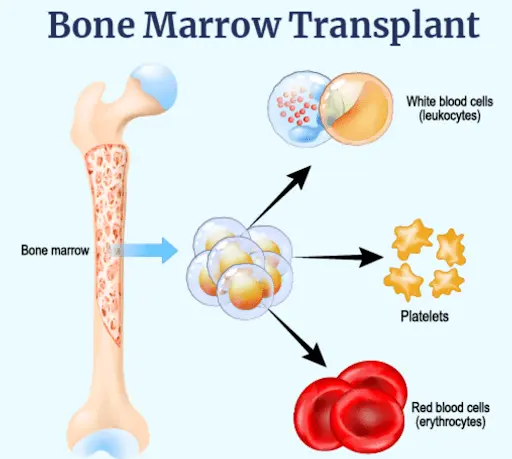
Bone marrow transplant (BMT)
- BMT involves replacing diseased blood-forming cells with healthy ones.
- Blood-forming cells, also known as blood stem cells, are immature cells located in the bone marrow, where they develop into red blood cells, white blood cells, and platelets.
- Once mature, these cells exit the bone marrow and circulate in the bloodstream.
Types of BMT
- Autologous transplant:
- In this method, blood-forming cells are harvested, preserved by freezing, and stored.
- Subsequently, they are returned to your body following chemotherapy (chemo) and sometimes radiation therapy.
- Allogeneic transplant:
- In this method, healthy blood-forming cells are donated by someone else.
- The donor can be a family member or someone unrelated to you.
- Haploidentical transplant:
- A haploidentical transplant is a form of allogeneic transplant where healthy blood-forming cells from a half-matched donor, usually a family member, are used to replace unhealthy cells.
About the Stem Cells:
- Stem cells are unique human cells with the ability to transform into various types of cells within the body, ranging from muscle cells to brain cells.
- Stem cell banking plays a crucial role in stem cell therapy.
Types of stem cell:
- Embryonic stem cells:
- These stem cells are present exclusively in the earliest stages of development.
- Adult stem cells:
- These are cells that proliferate to repair adult organs and tissues when needed.
- They are found in nearly all human body organs and are multipotent, capable of generating a limited range of mature cell types specific to their residing tissues.
- An example is hematopoietic stem cells in bone marrow, which produce various blood cells.
- Certain tissue-specific stem cells, known as unipotent or bipotent, generate one or two types of mature cells; for instance, skin stem cells regenerate skin cells as unipotent cells.
- Induced pluripotent stem cells, or iPSCs:
- These cells are artificially created in laboratories using cells from the body.
- iPSC cells exhibit characteristics akin to embryonic stem cells and were first successfully generated in humans in 2007.
Source: (TH)
Chief of Army Staff
Why in the news ?
- Recently, the central government appointed General Upendra Dwivedi as the 30th chief of the Indian Army.
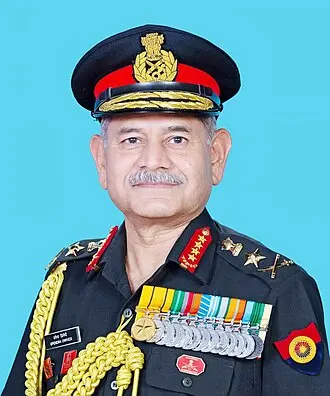
Roles and Responsibilities:
- Overall Functioning: Responsible for overseeing command, control, administration, and strategic operations of the Indian Army (IA).
- Preparation and Maintenance: Ensures readiness, maintenance, and operational effectiveness of troops, equipment, facilities during peacetime and conflict.
- National Security: Protects the nation's territorial integrity and sovereignty during armed conflicts or war.
- Advisory Role: Advises the Central Government on all matters related to the Indian Army.
- Judicial Responsibilities: Convenes court-martials as directed by the Central Government to review cases of misconduct. Reviews judicial sentencing and pleas of officers convicted of professional misconduct.
- Committee Memberships: Permanent member of Chiefs of Staff Committee (COSC), National Security Council (NSC), Defence Planning Committee (DPC), and Defence Acquisition Council (DAC).
- Advisory Role in Defence Affairs: Advises the Minister of Defence (Raksha Mantri or RM) on IA operations, tri-service integration, doctrinal strategy, capability development, defence acquisition, and infrastructure planning.
Structure:
As the professional head of the force, the COAS is assisted by one subordinate officer and three principal staff officers:
- Subordinate:
- Vice Chief of Army Staff (VCOAS)
- Principal Staff Officers:
- Deputy Chief of the Army Staff (Capability Development and Sustenance) (DCOAS - CD&S)
- Deputy Chief of the Army Staff (Information Systems and Coordination) (DCOAS - IS&C)
- Deputy Chief of the Army Staff (Strategy) (DCOAS - Strategy)
Retirement:
- Accordance with the Army (Amendment) Regulations, 2022 - a COAS-appointee reaches superannuation upon the completion of three years in the position or at the age of 62.
Source: TH
Rail link for Chabahar-Zahedan
Why in the news ?
- Recently, India and Iran plan to fasttrack the development of a new rail connectivity route between the Chabahar port and Zahedan city.
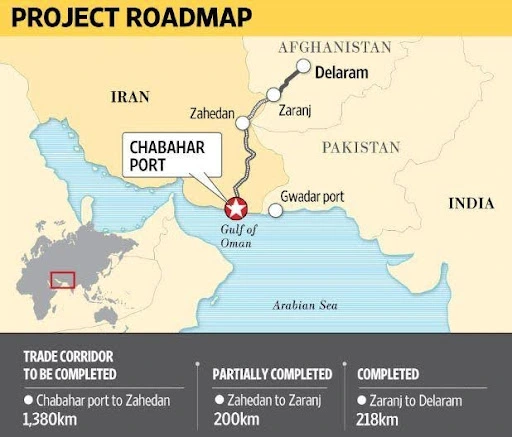
About the Chabahar Port:
- Location: Located in Iran’s Sistan-Baluchistan province, at the Gulf of Oman’s entrance to the Strait of Hormuz.
- Sections: Consists of two sections: Shahid Beheshti and Shahid Kalantari.
- Strategic Position:
- Strategically located near Afghanistan, Pakistan, and India. It serves as Iran’s only port with direct access to the Indian Ocean.
- It plays a crucial role in the International North-South Transport Corridor (INSTC), enhancing its status as a key commercial hub in the region.
International North-South Transport Corridor (INSTC):
- Connectivity & Length:
- Extends over 7,200 kilometres, integrating road, rail, and maritime routes.
- It links Russia and India via Central Asia and Iran, providing a direct route from the Caspian Sea to the Indian Ocean through the Persian Gulf.
- It further extends to Northern Europe.
- Components:
- Northern and Western Europe via the Russian Federation
- Caucasus to the Persian Gulf (Western route)
- Central Asia to the Persian Gulf (Eastern route)
- Caspian Sea through Iran to the Persian Gulf (Central route)
Source: LM
India's Northeast Unexplored Frontier
Context:
- Despite its rich natural resources and vibrant cultural identity, India's Northeast grapples with challenges such as inadequate infrastructure, restricted market access, social inequalities, and recent conflicts like those in Manipur.
- Investing in this region could unlock a treasure trove of cultural richness, economic opportunities, and environmental stewardship.
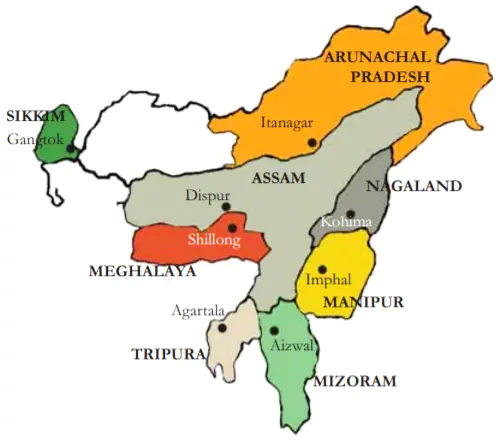
What is the Significance of the North-East Region for India?
- Strategic Geopolitical Location:
- The Northeast serves as a vital economic corridor linking India with Southeast Asia.
- Initiatives like the India-Myanmar-Thailand Trilateral Highway and Kaladan Multi-Modal Transit Transport Project aim to enhance connectivity and bolster India's presence in Southeast Asia, aligning with the 'Act East' policy.
- Rich Biodiversity and Natural Resources:
- Globally recognized as a biodiversity hotspot, the Northeast hosts rare flora and fauna in diverse ecosystems from rainforests to alpine meadows.
- It holds significant reserves of oil, natural gas, and coal, crucial for India's economic growth.
- Cultural Diversity and Ethnic Mosaic:
- With over 220 ethnic groups and diverse traditions, languages, and heritage, the Northeast enriches India's cultural identity. Its vibrant arts, crafts, music, and culinary traditions offer immense potential for cultural tourism.
- Agricultural and Horticultural Potential:
- The Northeast's varied climate supports cultivation of high-value crops and organic farming.
- It is poised for growth in floriculture, medicinal plants, and meets global demand for natural products.
- Hydroelectric Power Generation:
- Abundant water resources and mountainous terrain provide the Northeast with significant hydroelectric potential, estimated at 58,000 MW, nearly 40% of India's total.
- Developing this resource can meet local energy needs and contribute to India's renewable energy targets.
- Tourism Potential:
- Pristine landscapes, unique wildlife, and cultural heritage sites like Kaziranga.Keibul Lamjao National Park and Meghalaya's living root bridges attract domestic and international tourists.
- Human Resource Development:
- With a high literacy rate of 78.5% and a youthful population, the Northeast offers a demographic dividend for India's future.
- Investments in education, skill development, and employment can transform the region into a hub for innovation and entrepreneurship.
What are the Major Challenges Related to India’s Northeast Region?
- Persistent Insurgency and Ethnic Conflicts:
- Despite peace accords with various groups, insurgency persists in Manipur and parts of Nagaland, driven by demands for autonomy.
- The recent 2023 violence between Meiteis and Kukis in Manipur underscores the fragile inter-ethnic relations, posing security threats and hindering development and investment.
- Agricultural Challenges:
- Despite being agrarian, the Northeast faces hurdles. Sikkim's organic farming success is limited due to low premium prices, certification complexities, and competition from cheap fertilisers.
- Middlemen dominance, exemplified by entities like the Ginger Growers Cooperative Federation, exacerbates issues, creating cycles of debt and market control, leaving farmers with minimal profits.
- China's Growing Influence and Border Disputes:
- China's claims over Arunachal Pradesh and border infrastructure developments pose significant security challenges.
- Recent clashes in Tawang (December 2022) and Dokhlam Region highlight tensions. China's economic influence in Myanmar further isolates the Northeast, challenging India's strategic interests.
- Climate Change and Environmental Degradation:
- The Northeast grapples with climate change impacts like erratic rainfall, flooding, and landslides, as seen in the 2022 Assam floods. These vulnerabilities threaten livelihoods and infrastructure.
- Infrastructure Deficit and Connectivity Issues:
- Despite the Act East Policy, infrastructure development lags. Slow progress on projects like the India-Myanmar-Thailand Trilateral Highway impedes economic integration with Southeast Asia.
- Poor last-mile connectivity in healthcare, education, and economic sectors affects remote areas disproportionately.
- Economic Underdevelopment and Unemployment:
- The region's agrarian economy with limited industrialization fosters high youth unemployment, driving social unrest and out-migration.
- Initiatives like the North East Industrial Development Scheme (2017) have had mixed success in attracting investments, exacerbating economic disparities.
- Drug Trafficking and Cross-border Crime:
- Proximity to the Golden Triangle exposes the Northeast to drug trafficking, particularly in Manipur and Mizoram.
- Increasing drug seizures pose law enforcement challenges and contribute to social issues like addiction, straining healthcare and social structures.

- Political Instability and Governance Issues:
- The Northeast faces frequent changes in government, particularly in states like Manipur and Arunachal Pradesh, disrupting policy continuity.
- Ethnic politics, demands for autonomy, and national political dynamics contribute to unstable coalitions.
- Recent controversies surrounding the Citizenship Amendment Act (CAA) have exacerbated the political landscape, leading to protests and inter-community tensions.
How can India Strengthen the Integration of Northeast India?
- "Northeast to Southwest" Cultural Exchange Program:
- Launch a comprehensive cultural exchange initiative between the Northeast and southwestern states of India.
- This program includes year-long student exchanges, artist residencies, and business incubation programs aimed at fostering deep connections and integration at a grassroots level.
- "Digital Silk Road" Initiative:
- This initiative includes creating a "Silicon Valley of the East," offering tax incentives for tech companies, specialised digital skills training, and focusing on technologies suited for mountainous and rural areas.
- This aims to integrate the Northeast into India's digital economy and potentially lead in optical fibre connectivity to Southeast Asian countries.
- Transnational Indigenous Knowledge University:
- Establish a world-class university and Invite scholars and students from India and Southeast Asian countries to study indigenous cultures, traditional medicine, sustainable agriculture, and ecological conservation.
- This initiative aims to position the Northeast as a cultural and intellectual bridge between South and Southeast Asia.
- Northeast Olympic Training Center:
- Establish a state-of-the-art Olympic training facility in the Northeast to train athletes in various Olympic sports.
- This centre aims to garner national and international attention, promote sports integration, and instil regional pride through athletics.
- Floating Markets Tourism Circuit:
- Develop a network of floating markets across Northeastern rivers, inspired by Southeast Asian models.
- This initiative aims to boost tourism, showcase regional diversity, stimulate local economies, and establish a unique Northeastern brand in India's tourism sector.
- Bamboo Revolution Program:
- Launch a national initiative centred on bamboo cultivation and product development in the Northeast.
- This program spans bamboo-based textiles, construction materials, and biofuels, aiming to drive economic growth and position the region as a leader in eco-friendly innovation.
- Himalayan Medicinal Research Corridor:
- Establish a specialised research and development corridor focusing on traditional Himalayan medicine in the Northeast.
- Integrate Northeastern knowledge with Ayurveda and modern biotechnology to position the region as a global leader in alternative medicine research and production.
- Autonomous Vehicle Testing Ground:
- Designate parts of the Northeast as testing zones for autonomous vehicles, leveraging its challenging terrain to attract global auto and tech companies.
- This initiative aims to integrate the region into the forefront of transportation technology development.
|
UPSC Civil Services Examination Previous Year Question (PYQ) Prelims: Q:1 Consider the following pairs: (2013)
Which of the above pairs are correctly matched?
Ans: (a) Q:2 Which Schedule of the Constitution of India contains special provisions for the administration and control of Scheduled Areas in several States? (2008)
Ans: (b) |
Source: EP
Share the article
Get Latest Updates on Offers, Event dates, and free Mentorship sessions.

Get in touch with our Expert Academic Counsellors 👋
FAQs
UPSC Daily Current Affairs focuses on learning current events on a daily basis. An aspirant needs to study regular and updated information about current events, news, and relevant topics that are important for UPSC aspirants. It covers national and international affairs, government policies, socio-economic issues, science and technology advancements, and more.
UPSC Daily Current Affairs provides aspirants with a concise and comprehensive overview of the latest happenings and developments across various fields. It helps aspirants stay updated with current affairs and provides them with valuable insights and analysis, which are essential for answering questions in the UPSC examinations. It enhances their knowledge, analytical skills, and ability to connect current affairs with the UPSC syllabus.
UPSC Daily Current Affairs covers a wide range of topics, including politics, economics, science and technology, environment, social issues, governance, international relations, and more. It offers news summaries, in-depth analyses, editorials, opinion pieces, and relevant study materials. It also provides practice questions and quizzes to help aspirants test their understanding of current affairs.
Edukemy's UPSC Daily Current Affairs can be accessed through:
- UPSC Daily Current Affairs can be accessed through Current Affairs tab at the top of the Main Page of Edukemy.
- Edukemy Mobile app: The Daily Current Affairs can also be access through Edukemy Mobile App.
- Social media: Follow Edukemy’s official social media accounts or pages that provide UPSC Daily Current Affairs updates, including Facebook, Twitter, or Telegram channels.

